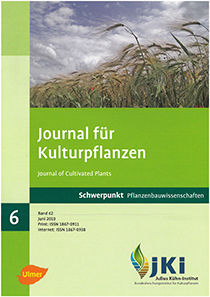Concentrations of U-238, U-235, Th-232 and Ra-226 in some selected raw phosphates, phosphate fertilizers, soil and plant samples from a long term P fertilization experiment
DOI:
https://doi.org/10.5073/JfK.2010.06.02Keywords:
Uranium, thorium, radium, phosphate fertilizers, phosphate rock, superphosphate, phosphate recycling, struvite, nuclide contaminationAbstract
In this paper we present the results of experiments measuring the concentrations of four nuclides (U-238, U-235, Th-232, Ra-226) in eight different phosphate rock (RP) samples from three continents, seven commercially used fertilizers and five P fertilizers from P recycling of waste materials. The total concentration of radioactive isotopes was determined with physical measurements. The uranium (U) concentration in the phosphate fraction of the fertilizers (mg U/kg P) was subsequently calculated.
Most phosphate rocks and the respective P fertilizers contained a specific U-238 activity of 96–1164 Bq kg–1 material, which was 10 to 100 times higher, when compared to the specific activity of basic slags or P fertilizers from P recycling and diammonium phosphate (DAP). The activity of U-235 in these phosphates was 9 to 17 times lower than that found in U-238. Apatite from the Kola Peninsula, which is of magmatic origin, contained a total of 5 mg U per kg substance. This was much lower (six to twenty times) than that of phosphate rock from Burkina Faso, Gafsa, North Carolina and Israel. For the commercial fertilizers, single superphosphate (SSP), triple superphosphate (TSP), “Novaphos”, “Hyperphos” and “Dolophos” the U content varies from 400 to 750 mg kg–1 P. P fertilizers recycled from waste water, sewage sludge, slurry etc. and DAP are only minimally contaminated by the measured nuclides. The Th-232 content of phosphate rocks and most of the P fertilizer samples that we measured ranged in concentration from below the detection limit up to 9 mg kg–1, except for the sample from Kola apatite, whose Th-232 concentration was 19 mg kg–1. DAP and fertilizers from P recycling were nearly free of Th-232. The Ra-226 content per kg material varied by the origin of the sample: 0.1 ng for P fertilizer from P recycling, 0.4 ng for basic slag, 1.9 ng for Kola apatite, and 3 to 31 ng for the phosphate rocks and for SSP and TSP. The measurement of U-238 activity of soil samples from a long-term P-fertilization field experiment showed the following values: Untreated plots: 34.1 Bq kg–1, plots with 900 kg P ha–1 (RP): 33.5 Bq kg–1, plots with 2700 kg P ha–1 (TSP): 33.9 Bq kg–1 soil. Independent of P fertilization, rape seeds contained 1.3–2.4 Bq kg–1, and rape straw showed values below the detection limit. That means fertilization with 2700 kg P ha–1 did not significantly increase U-238 activity in soils and plants. Conclusions: The present low contamination of agricultural land should be maintained by fertilizers low in nuclide contents. Especially fertilizers from P recycling and manure can be recommended because they are nearly free of toxic nuclides. Low cost technologies for the production of low nuclide P fertilizers have to be developed. Available long term P fertilization field experiments in Germany should be used for a more accurate assessment of the real toxicity danger caused by P fertilizers. The plots of the field experiments have to be analysed not only in the upper 25 cm but also in the deeper layers. Plant breeders should develop new crop cultivars with a very low genetic potential of U uptake and translocation into shoots.
Downloads
Published
Issue
Section
License
The content of the journal is licensed under the Creative Commons Attribution 4.0 License. Any user is free to share and adapt (remix, transform, build upon) the content as long as the original publication is attributed (authors, title, year, journal, issue, pages).
The copyright of the published work remains with the authors. The authors grant the Journal of Cultivated Plants, the Julius Kühn-Institut and the OpenAgrar repository the non-exclusive right to distribute and exploit the work.







